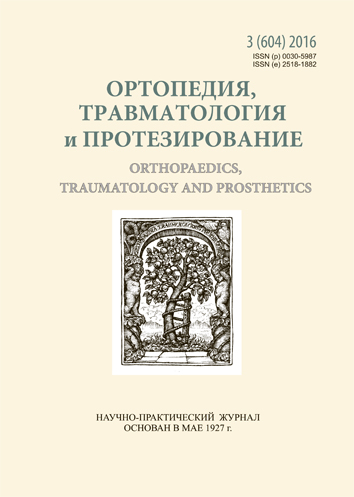Clinical and experimental study of micro-mobility of fragments of the tibia under external fixation rod
DOI:
https://doi.org/10.15674/0030-59872016354-60Keywords:
fractures, tibia, external fixation, fragment mobility, load, amplitude, regenerationAbstract
Research the mobility of bone fragments after the fracture and its impact on reparative regeneration is essential and urgent. Physical parameters (amplitude, direction of displacement), transposition of fragments that stimulate regeneration and, conversely, destroy regenerate should be emphasized out of the undetermined data. It is also necessary to clarify the dependence of these parameters on the location, injury characteristics and bone regeneration stage, is always mobility leads to the formation of callus and its absence to the initial fusion, or should be fragments nobility taken into consideration during implant developing.
Objective:to investigate the mobility of tibial fracture fragments under the conditions of external single-rod fixation in the clinical situation.
Methods: unilateral external fixation support, which provides the possibility of tibial longitudinal fixation of stiffness adjusting is developed. For clinical studies specific stand developed, allowing self-loaded by patients of damaged leg until the pain symptoms. Using special device load segment and mutual longitudinal displacement of fragments recorded.
Results: for the first 6 weeks amplitude displacement of tibial bone fragments decreased from (2.3 ± 0.2) to (0.8 ± 0.2) mm. The shift occurred under the influence of the axial load of (210 ± 15) to (751 ± 15) N. After 6 weeks fixator stiffness and increased bone regenerate resistance prevented regenerate functional training and restructuring.
Conclusions:pain occurring in the area of the fracture may be the marginal criterion of breaking load. The necessary (stimulatory) and acceptable (regenerate nondestroying) amplitudes of bone fragments displacement are specific to each location and type of fracture, under conditions of regeneration stage and fixation.References
- Aksolonov AA, Ustyantcev VN, Yarkov AG, Bondarenko AV. Managed unstable osteosynthesis in the treatment of fractures of long bones. Devices and methods of external fixation in traumatology and orthopedics. Riga, 1985;1:123–125.
- Kalnberz VK. Key biomechanical features of spoke external fixation of bones. Janson: mes. rep. International Conf «Advances of biomechanics in medicine». Riga, 1986;3:475–480.
- Bets GV, Ostroverh SA, Bets VG. To the question about the influence of the stiffness of external fixation of bone fragments in the formation and reorganization of regenerate (conceptual model). Orthopedics, Traumatology and Prosthetics. 2001;4:91-92.
- Popsuyshapka AK. Functional treatment of diaphyseal bone fractures of the limb (clinical and experimental study): dis. the doctor of medical sciences. Kharkiv, 1991. 271 p.
- Kalnberz VK. Compression apparatus of tense and rigid system: guidelines. 2nd additional. ed. Riga, 1981. 68 p.
- Kalnberz VK, Muyzhulis AK, Novikov PY. Some possibilities of improving the results of treatment of patients with diaphyseal fractures of the tibia. Orthopaedics and Traumatology. 1983;11:18–21.
- Bets GV, Ostroverh SA, Bets VG. Study of stiffness fixation of bone fragments by the extrafocal rod devices. Orthopedics, Traumatology and Prosthetics. 2002;4:90–92.
- Tkachev AV, Beidik OV. Biomechanical study of the stiffness of external fixation in the treatment of long bone fractures using of transossal osteosynthesis. Biomedical technology and radioelectronics. 2006;8-9:100-104.
- Tkachev AV. Biomechanical systems of external fixation in the treatment of tibial fractures: аbstract dis. the kand. med. nauk. Saratov, 2006.18 p.
- Ruedi TP, Buckley RE, Moran KG. AO — principles of fractures treatment. 2nd ed., revised. and ext. - Vassamedia, 2013;1:20-21.
Downloads
How to Cite
Issue
Section
License
Copyright (c) 2016 Grygorii Bets, Iryna Bets, Ivan Stoyko

This work is licensed under a Creative Commons Attribution 4.0 International License.
The authors retain the right of authorship of their manuscript and pass the journal the right of the first publication of this article, which automatically become available from the date of publication under the terms of Creative Commons Attribution License, which allows others to freely distribute the published manuscript with mandatory linking to authors of the original research and the first publication of this one in this journal.
Authors have the right to enter into a separate supplemental agreement on the additional non-exclusive distribution of manuscript in the form in which it was published by the journal (i.e. to put work in electronic storage of an institution or publish as a part of the book) while maintaining the reference to the first publication of the manuscript in this journal.
The editorial policy of the journal allows authors and encourages manuscript accommodation online (i.e. in storage of an institution or on the personal websites) as before submission of the manuscript to the editorial office, and during its editorial processing because it contributes to productive scientific discussion and positively affects the efficiency and dynamics of the published manuscript citation (see The Effect of Open Access).














